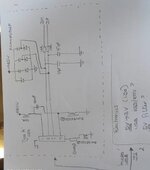Rajinder1268
Full Member level 3
Hi all,
I have attached a schematic of my design. This is part of electronics that will get power from a USB connector from a portable device.
I have connected the USB connector to ground via ferrite beads to reduce EMI. However have seen multiple threads of the connector shield being connected straight to GND, or with a RC parallel connection. I am not sure what is correct. Looking at FTDI hardware guidelines, they have the reference designs connected directly to GND. Can anyone help clear this up?
I am using a 2 layer board. GND on the bottom layer, signals on top and power on top. Should the USB connector be placed with no GND underneath? Finally how do I achieve a ,90ohm differential with a 2 layer board i.e. stack up (assuming 1oz copper). I am not sure how to use Saturn PCB tools. Thanks in advance.
I have attached a schematic of my design. This is part of electronics that will get power from a USB connector from a portable device.
I have connected the USB connector to ground via ferrite beads to reduce EMI. However have seen multiple threads of the connector shield being connected straight to GND, or with a RC parallel connection. I am not sure what is correct. Looking at FTDI hardware guidelines, they have the reference designs connected directly to GND. Can anyone help clear this up?
I am using a 2 layer board. GND on the bottom layer, signals on top and power on top. Should the USB connector be placed with no GND underneath? Finally how do I achieve a ,90ohm differential with a 2 layer board i.e. stack up (assuming 1oz copper). I am not sure how to use Saturn PCB tools. Thanks in advance.
